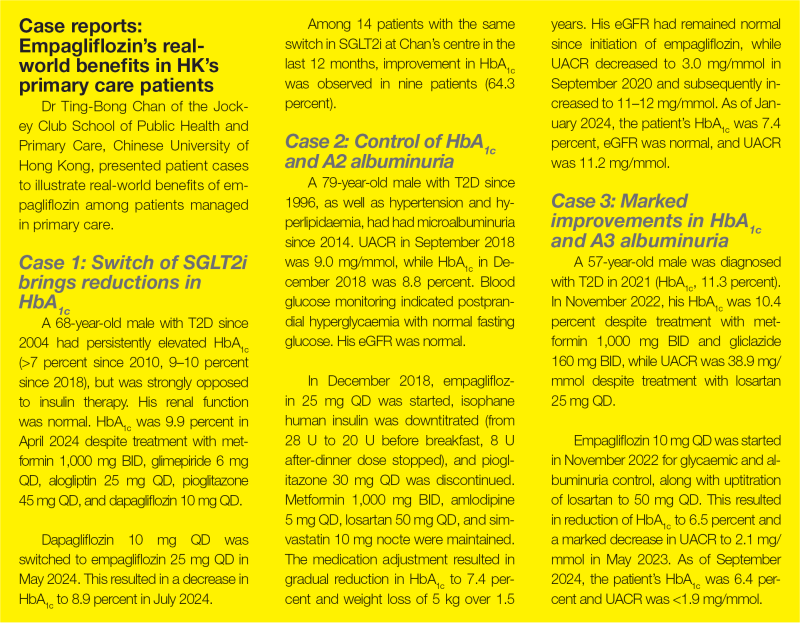CKD management in primary care: Why use SGLT2i?












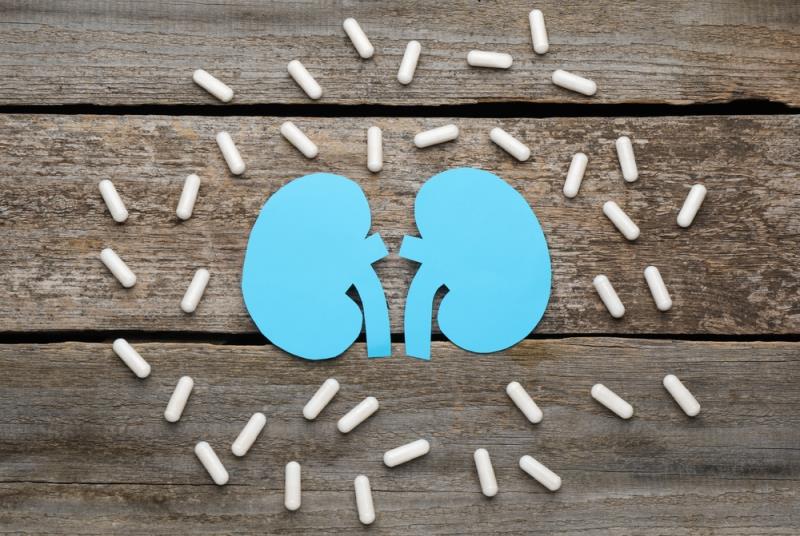
Primary care physicians, as patients’ first point of contact, play an important role in early detection and timely management of chronic kidney disease (CKD). Sodium-glucose cotransporter-2 inhibitors’ (SGLT2i) positive data in CKD trials have established their role as first-line therapy recommended by international and Hong Kong guidelines. At an industry-sponsored symposium organized by the Hong Kong College of Family Physicians, experts reviewed empagliflozin’s benefits in broad populations of CKD patients, and discussed how its early initiation may slow CKD progression and delay dialysis. Case reports were presented to illustrate real-world benefits of empagliflozin among patients managed in primary care in Hong Kong.
CKD: Scope of the problem in HK
Diabetes is the leading cause of end-stage kidney disease (ESKD) in Hong Kong and accounted for 51.5 percent of incident kidney replacement therapy (KRT) cases, followed by glomerulonephritis (18.7 percent) and hypertension (11.7 percent), according to latest 2022 data from the Hong Kong Renal Registry. [Hong Kong Med J 2024;30:332-336]
“Family physicians play a key role in early detection and timely management of CKD, given the large number of patients with diabetes or hypertension managed in primary care,” said Dr Catherine Xiao-Rui Chen of the Department of Family Medicine and Primary Healthcare, Kowloon Central Cluster, Hospital Authority (HA).
“In HA’s General Outpatient Clinics [GOPCs], the number of patients with diabetes or hypertension has been increasing at an annual rate of approximately 5 percent over the last few years,” Chen reported. “As of the third quarter of 2023, around 65 percent [n=347,653] of HA’s patients with type 2 diabetes [T2D] were managed in GOPCs. Between the fourth quarter of 2022 and the third quarter of 2023, HA’s GOCPs provided service to 690,162 patients with hypertension.”
According to a single-centre study, based on estimated glomerular filtration rate [eGFR] <60 mL/min/1.73 m2, 15.3 percent of Chinese hypertensive patients managed in primary care had CKD. [Cardiology and Cardiovascular Medicine 2022;6:268-283]
CKD staging by eGFR among adults with diabetes followed up in HA revealed a predominance (81 percent) of stage 1–2 CKD (eGFR ≥60 mL/min/1.73 m2) in 2022. “Despite our ageing population, the proportion of HA’s adult diabetes patients with stage 3a–4 CKD had decreased in 2019– 2022. This is probably due to introduction of effective therapies, such as SGLT2i and renin-angiotensin system inhibitors [RASi],” Chen noted.
Empagliflozin beneficial in broad CKD populations
“Although SGLT2i demonstrated cardiorenal benefits in CKD trials, earlier trials, such as CREDENCE and DAPA-CKD, did not include patients with normal to mildly increased urinary albumin-to-creatinine ratio [UACR] [<30 mg/g or <3 mg/mmol], who are also at increased risk of poorer prognosis in case of reduced eGFR,” said Professor Per-Henrik Groop of the University of Helsinki, Finland. (Figure 1) [Kidney Int 2024;105:S117-S314; N Engl J Med 2019;380:2295-2306; N Engl J Med 2020;383:1436-1446; J Am Soc Nephrol 2009;20:1813-1821] “In clinical practice, about 20 percent of patients with T2D never develop albuminuria.”
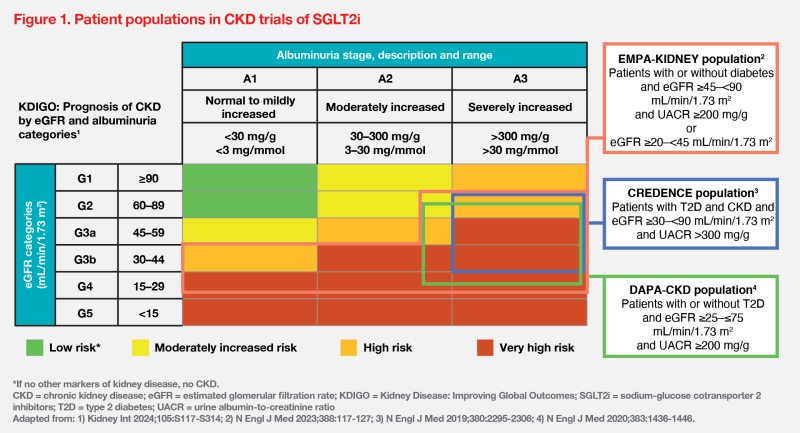
In contrast, the EMPA-KIDNEY trial of empagliflozin vs placebo was conducted in a broad population of CKD patients (n=6,609; mean age, 63.8 years; female, 33.2 percent), including those with normal to mildly increased UACR. Its eGFR cut-off was 20 mL/min/1.73 m2 – the lowest among SGLT2i trials in CKD. (Figure 1) [N Engl J Med 2023;388:117-127]
At baseline, 54 percent of EMPA-KIDNEY patients did not have diabetes, and approximately 73 percent did not have a history of cardiovascular disease (CVD). Median UACR was 329 mg/g, and 20.1 percent of patients had UACR <30 mg/g. Mean eGFR was 37.3 mL/min/1.73 m2, and 34.5 percent of patients had eGFR <30 mL/min/1.73 m2. The most common cause of kidney disease was diabetic kidney disease (about 31 percent), followed by glomerular disease (about 25 percent) and hypertensive or renovascular disease (about 22 percent).
“EMPA-KIDNEY’s population is reflective of CKD patients seen in clinical practice, including in primary care. Its population also had the lowest CV risk compared with other SGLT2i trials in CKD,” said Groop.
Reduced risk of CKD progression or CV death
After a median follow-up of 2 years, EMPA-KIDNEY demonstrated a 28 percent relative risk reduction (RRR) in the primary composite outcome of kidney disease progression (ESKD, a sustained decrease in eGFR to <10 mL/min/ 1.73 m2, a sustained decrease in eGFR of ≥40 percent from baseline, or death from renal causes) or death from CV causes with empagliflozin vs placebo (hazard ratio [HR], 0.72; 95 percent confidence interval [CI], 0.64–0.82; p<0.001). (Figure 2) [N Engl J Med 2023;388:117-127]

“Empagliflozin’s benefit on the primary composite outcome was consistent across subgroups, irrespective of primary kidney diagnosis, diabetes status, eGFR, and RASi use at baseline,” said Groop.
The trial also showed a 29 percent RRR in kidney disease progression (HR, 0.71; 95 percent CI, 0.62–0.81) and a 14 percent RRR in all-cause hospitalization (first and recurrent) (HR, 0.86; 95 percent CI, 0.78–0.95; p=0.003) with empagliflozin vs placebo. [N Engl J Med 2023;388:117-127]
Slower eGFR decline across UACR spectrum
“In patients at lower risk of CKD progression, such as those with lower albuminuria levels, annual rate of change in eGFR is a more sensitive measure of treatment effect,” explained Groop. “HR is a measure of risk. In patients with A1 or A2 albuminuria, results in terms of HR [in the primary composite outcome] are unlikely to be seen after 2 years of follow-up.”
“In EMPA-KIDNEY, the annual rate of change in eGFR between 2 months and final follow-up [long-term eGFR slope] was twice slower in the empagliflozin vs placebo group [mean, -1.37 vs -2.75 mL/ min/1.73 m2/year; between-group difference, 1.37 mL/min/1.73 m2/year],” he pointed out. [N Engl J Med 2023;388:117-127] “Thus, it would take 20 vs 10 years for patients in the empagliflozin vs placebo group to develop kidney failure [eGFR <10 mL/min/1.73 m2].”
“Empagliflozin’s beneficial effect on annual rate of change in eGFR was observed across the spectrum of UACR, including in patients with normal to mildly increased UACR,” he added. (Table)
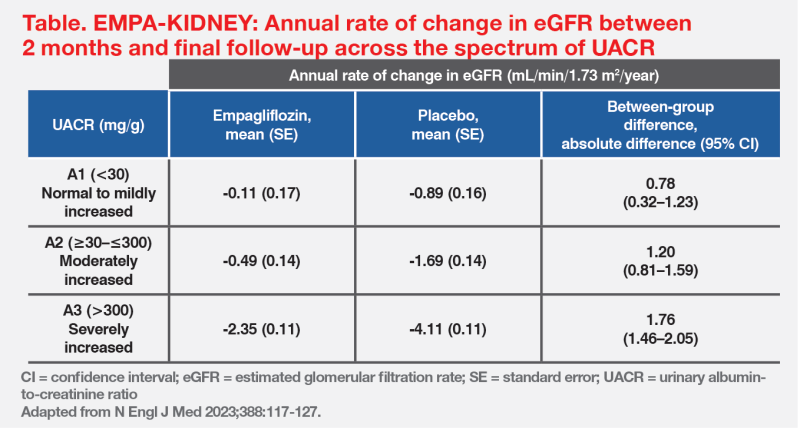
Early start of empagliflozin may delay dialysis
Extrapolation of long-term eGFR slope data from the EMPA-KIDNEY trial suggests potential delays in KRT with early initiation of SGLT2i. [Clin Kidney J 2023;16:1187-1198]
“Based on long-term eGFR slopes in EMPA-KIDNEY, early initiation of empagliflozin at an eGFR of 85 mL/min/1.73 m2 is estimated to delay KRT by 26.6 years vs placebo and can potentially avoid >4,000 haemodialysis sessions per patient,” said Dr Maggie Ma of the Combined Renal Replacement Services, Queen Mary Hospital. “When initiated at an eGFR of 20 mL/min/1.73 m2, empagliflozin is estimated to delay KRT by 1.9 years vs placebo and avoid 301 haemodialysis sessions per patient.” (Figure 3)
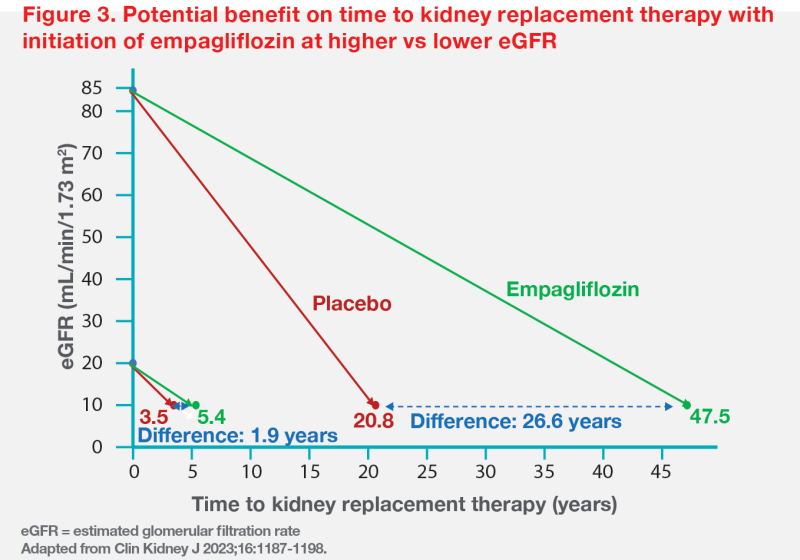
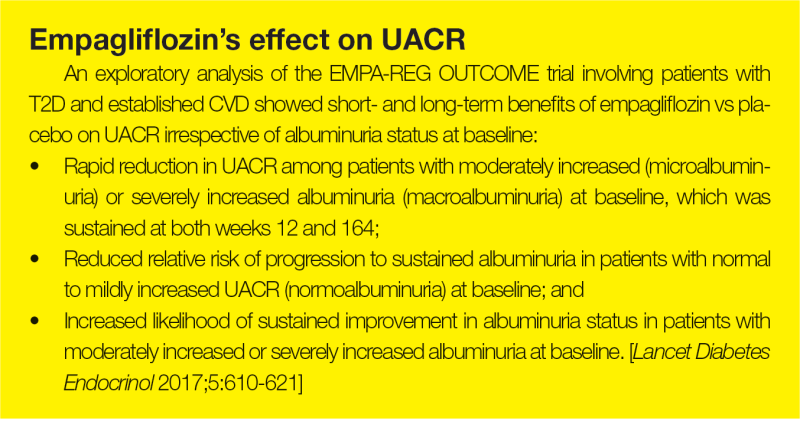
International & HK guidelines: SGLT2i as first-line therapy
“SGLT2i are one of the pillars of treatment recommended by multiple international guidelines for patients with cardiorenal conditions to reduce the risk of complications,” said Groop.
2024 CKD guideline of Kidney Disease: Improving Global Outcomes (KDIGO), for example, recommends SGLT2i as first-line therapy for most patients with CKD, with or without T2D. “The level of recommendation is 1A for CKD patients with T2D and eGFR ≥20 mL/min/1.73 m2, 1A for CKD patients with eGFR ≥20 mL/min/1.73 m2 and UACR ≥200 mg/g, 1A for CKD patients with heart failure [HF] irrespective of albuminuria level, and 2B for CKD patients with eGFR of 20–45 mL/min/1.73 m2 and UACR <200 mg/g,” said Groop. [Kidney Int 2024;105:S117-S314]
“SGLT2i are also recommend by American Diabetes Association’s 2024 guidelines as first-line therapy for T2D patients with CKD, HF, atherosclerotic CVD or other indicators of high risk,” said Ma. [Diabetes Care 2024;47(Suppl 1):S158-S178]
“Hong Kong’s expert consensus recommendation on CKD management highlights SGLT2i as first-line therapy for glycaemic control and cardiorenal protection in patients with T2D and CKD whose eGFR is ≥20 mL/min/1.73 m2. In nondiabetic CKD patients with eGFR ≥20 mL/min/1.73 m2 and UACR ≥200 mg/g [≥20 mg/mmol], SGLT2i can be prescribed for cardiorenal protection,” said Chen. [Hong Kong Med J 2024;doi:10.12809/hkmj2311309]
“Cardiorenal benefits of SGLT2i are independent of glucose-lowering effects,” Chen continued. “For cardiorenal protection, empagliflozin 10 mg QD can be initiated in patients with eGFR ≥20 mL/min/ 1.73 m2. If additional glycaemic control is needed in patients with eGFR ≥30 mL/ min/1.73 m2, an increased dose of 25 mg QD can be considered.” [Jardiance Hong Kong Prescribing Information]
“An initial dip in eGFR is expected shortly after SGLT2i initiation. There is no need to worry if the dip is <30 percent. In such cases, continue monitoring, and eGFR would gradually return to baseline levels in most cases,” Chen advised.
